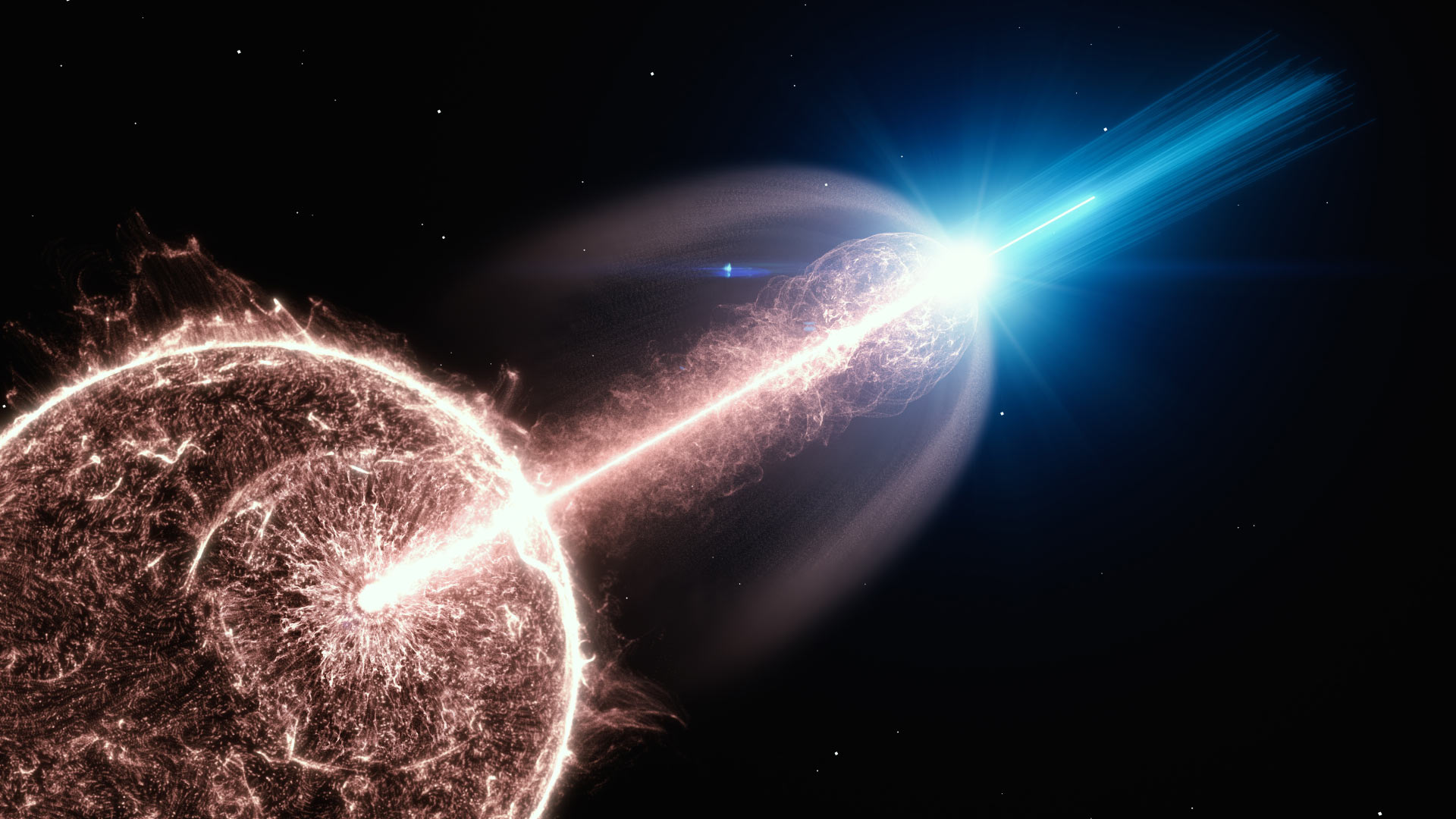
Gamma-ray bursts (GRBs) are some of the most enigmatic and captivating phenomena in the universe. These powerful bursts of gamma-ray radiation can release as much energy in a few seconds as the Sun does in its entire lifetime. GRBs were first discovered in the late 1960s by military satellites designed to detect nuclear weapons tests, but it wasn’t until decades later that scientists began to unravel the secrets of these celestial explosions.
In this article, we will delve into 15 astonishing facts about gamma-ray bursts that will leave you in awe of the sheer magnitude and complexity of these cosmic events. From their origins and classifications to their mind-boggling energy release and potential implications for our understanding of the universe, prepare to be amazed by the incredible world of gamma-ray bursts.
Key Takeaways:
- Gamma-ray bursts are the most powerful explosions in the universe, releasing more energy in a few seconds than the Sun emits in its entire lifetime. They can be detected from billions of light-years away.
- Gamma-ray bursts, both short and long, offer valuable insights into the early universe and are used to study the composition and evolution of galaxies in the distant past.
Gamma-ray bursts are the most energetic explosions in the universe.
Gamma-ray bursts (GRBs) release more energy in a few seconds than our Sun will emit over its entire lifetime. These cosmic events are incredibly powerful and can be detected from billions of light-years away.
Gamma-ray bursts are brief but intense bursts of gamma rays.
GRBs typically last for just a few milliseconds to a few minutes, but they emit gamma rays that are billions of times more energetic than visible light.
There are two main types of gamma-ray bursts.
Gamma-ray bursts are classified into two categories: short-duration bursts, lasting less than two seconds, and long-duration bursts, lasting more than two seconds.
Gamma-ray bursts can originate from supernovae.
Some long-duration gamma-ray bursts occur when massive stars undergo supernova explosions. The collapsing core of the star forms a black hole, releasing a tremendous amount of energy in the form of gamma rays.
Gamma-ray bursts can also be created by merging neutron stars.
Short-duration gamma-ray bursts are believed to be the result of two neutron stars merging together. The merging process releases an intense burst of gamma rays before forming a black hole or a highly magnetized neutron star.
Gamma-ray bursts can be used to study the early universe.
The light from gamma-ray bursts can provide valuable information about the early universe, as it traveled billions of years to reach us. By analyzing this light, astronomers can study the composition and evolution of galaxies in the distant past.
The duration of a gamma-ray burst depends on the angle of observation.
If a gamma-ray burst is not directed towards Earth, it may appear shorter in duration due to the angle of observation. This makes it difficult to precisely determine the actual duration of these bursts.
Gamma-ray bursts can cause atmospheric ionization on Earth.
When a gamma-ray burst occurs within a certain distance from Earth, it can cause ionization in our planet’s upper atmosphere. This ionization can potentially affect satellite communications and disrupt electronic systems.
Gamma-ray bursts were first discovered accidentally.
In the late 1960s, the United States Vela satellites, originally designed to detect nuclear tests in space, detected unexplained bursts of gamma rays. These were later identified as gamma-ray bursts, leading to further investigation.
Gamma-ray bursts are extremely rare.
Considering the vastness of the universe, gamma-ray bursts are remarkably infrequent events. On average, there is only about one gamma-ray burst every few million years within our galaxy.
The afterglow of gamma-ray bursts can be detected across different wavelengths.
After the initial burst of gamma rays, gamma-ray bursts continue to emit radiation across various wavelengths, including X-rays, visible light, and radio waves. Observing the afterglow helps scientists understand the physics behind these extraordinary events.
Gamma-ray bursts can be used as cosmic beacons.
Due to their high energy and visibility over long distances, gamma-ray bursts can serve as cosmic beacons to help astronomers map the large-scale structure of the universe.
The origin of gamma-ray bursts was a mystery for many years.
It wasn’t until the late 1990s that astronomers determined the origin of gamma-ray bursts. The discovery that some bursts were associated with certain types of supernovae and merging neutron stars provided crucial insights into their formation.
Gamma-ray bursts are used to test theories of gravity.
The study of gamma-ray bursts helps scientists test the predictions of Einstein’s theory of general relativity and explore alternative theories of gravity in extreme conditions.
Gamma-ray bursts continue to be an active area of research.
Scientists around the world are continuously studying gamma-ray bursts to gain a deeper understanding of their origins, impact, and potential applications in astrophysics.
Conclusion
Gamma-ray bursts are some of the most fascinating and mysterious phenomena in the Universe. From their incredible power to their fleeting nature, they continue to captivate scientists and enthusiasts alike. The 15 astonishing facts about gamma-ray bursts highlighted in this article shed light on their origins, characteristics, and the scientific advancements made in their study.
As we delve deeper into the mysteries of these cosmic explosions, we unlock new insights into the nature of the Universe itself. Gamma-ray bursts serve as cosmic beacons, revealing information about the early Universe, stellar evolution, and the process of black hole formation. As technology advances, we can expect further discoveries and a better understanding of these extraordinary events that occur billions of light-years away.
With ongoing research and space missions devoted to studying gamma-ray bursts, we can look forward to uncovering even more astonishing facts about these cosmic marvels in the future.
FAQs
Q: What causes gamma-ray bursts?
A: Gamma-ray bursts are thought to be caused by various events, such as the collapse of massive stars or the collision of neutron stars.
Q: How long do gamma-ray bursts last?
A: Gamma-ray bursts can range in duration from a fraction of a second to several minutes.
Q: Can gamma-ray bursts harm Earth?
A: Most gamma-ray bursts occur billions of light-years away and pose no direct threat to Earth. However, if a nearby burst were to occur, it could have severe implications for life on our planet.
Q: Can we detect gamma-ray bursts with the naked eye?
A: No, gamma-ray bursts emit extremely high-energy radiation that is invisible to the naked eye. They are detected using specialized instruments and satellites.
Q: Are gamma-ray bursts the most powerful explosions in the Universe?
A: Yes, gamma-ray bursts are among the most energetic explosions known to occur in the Universe, releasing vast amounts of energy in a short period.
Q: Are there different types of gamma-ray bursts?
A: Yes, there are two main types of gamma-ray bursts: long-duration bursts, which last for more than two seconds, and short-duration bursts, which last for less than two seconds.
Q: Can gamma-ray bursts be used for space travel?
A: While gamma-ray bursts are incredibly powerful, they are too unpredictable and dangerous to be used for space travel. Spacecraft would need to be shielded from their intense radiation.
Q: How do scientists study gamma-ray bursts?
A: Scientists study gamma-ray bursts using a combination of satellites, ground-based observatories, and international collaborations. They analyze the bursts’ characteristics, such as the duration, energy spectrum, and afterglow, to gain insights into their origins.
Q: Can gamma-ray bursts be used to study the early Universe?
A: Yes, gamma-ray bursts can act as cosmic time capsules, providing insights into the early Universe due to their immense distance from Earth and their correlation with massive star formation.
Q: Have gamma-ray bursts ever been observed in our own galaxy?
A: Yes, gamma-ray bursts have been observed in our own galaxy, the Milky Way. However, they are extremely rare events due to the vast distances involved.
Gamma-ray bursts continue to captivate astronomers and space enthusiasts alike. Their incredible power and brief nature make them some of the most fascinating phenomena in the cosmos. If you're eager to learn more about these cosmic explosions, consider exploring the astonishing facts about gamma-ray burst afterglows, which shed light on the lingering effects of these powerful events. Surveys of gamma-ray burst afterglows provide valuable insights into their behavior and characteristics over time. Additionally, delving into the mind-blowing facts about gamma-ray burst progenitors can help you understand the origins of these magnificent cosmic events.
Was this page helpful?
Our commitment to delivering trustworthy and engaging content is at the heart of what we do. Each fact on our site is contributed by real users like you, bringing a wealth of diverse insights and information. To ensure the highest standards of accuracy and reliability, our dedicated editors meticulously review each submission. This process guarantees that the facts we share are not only fascinating but also credible. Trust in our commitment to quality and authenticity as you explore and learn with us.


